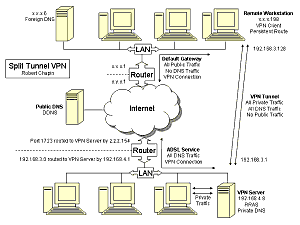
Anyone who has attempted a Virtual Private Network (VPN) connection in Windows XP has run into this problem: You want to have access to computers at your home or office, but Windows accomplishes this by routing all of your activity to the home network. If your work involves transferring files to a server and surfing the Internet, then your Internet activity has to piggyback on the VPN and travel twice within your limited home bandwidth. This means your slow VPN is even slower when you load a website, and any interruption of the VPN will break all of your connections to FTP sites, IM services, etc.
You may have tried to coerce Windows into routing your traffic to two different gateways, but quickly realized it wasn’t designed to do that. Adding entries to the local routing table can solve the problem temporarily, but doing so requires administrative privileges and ugly dynamic logic to handle a gateway address that changes every time you connect the VPN.
My solution for this scenario comes in two parts: 1. A static address for the VPN client computer, and 2. A persistent route for the VPN client’s static address. This is a bit easier said than done, so the following tutorial includes screenshots and details.
